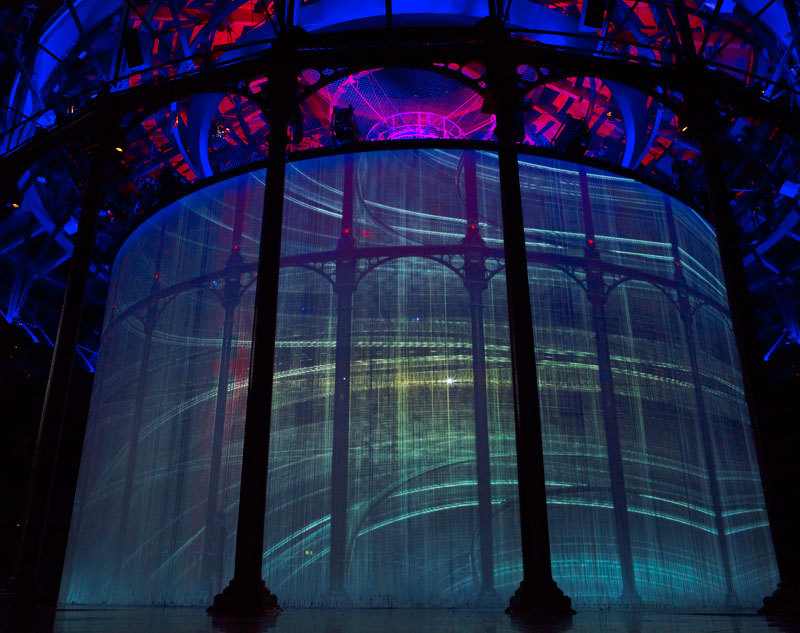
“I’ve never had boundaries. They’re not interesting. I don’t need anyone to tell me this is art, this is architecture. This is it. Do you like it? Enjoy it? Suffer from it? Does it excite you?”
Israeli-born Ron Arad, famous as much for his adjustable Bookworm shelf and Rover Chair (1981) as for his architecturally triumphant Design Museum in Holon (near Tel Aviv) has produced a typically definition-proof work in his new installation at the Roundhouse.
In the guise of what the Romans would have called an artifex – craftsman, artist, weaver of fable combined, Arad has spun out something quite enchanting in Curtain Call.
The piece comprises a screen of silicon rods suspended from the theatre ceiling so as to produce an undulating, cylindrical space. The rod screen provides both an interior and exterior surface for other artists’ videos to be projected onto; the inner space a stage for musicians and actors. A round theatre within a round theatre – what could be simpler?
In fact, Arad ’s construction is monumentally clever. Viewing the moving images on the outside of the space permits a far more passive type of viewing than that achievable from the inside.
Entering the space itself is a lot like climbing into a giant zoetrope. Having stepped through the curtain one is confronted by sound and moving image from every direction and – throughout this month – a host of different performances in the circle’s centre.
Photographer Eadweard Muybridge (1830-1904) famously used the zoetrope to create early moving images: horses galloping across a plain and the like – in an early precursor to the cinematic age. Several of the videos played across Arad ’s curtain employ familiar, Muybridgesque repetition. This is particularly true of fashion designer Hussein Chalayan’s images of besuited (in his own AW2011 collection) models falling into increasingly contorted poses. Standing within the curtain one witnesses the models approach, then ebb away with almost domino effect across the concave screen.
With its surface of moving electronic imagery, this is 21st century media set into the notion of a mechanical toy, circa 1870.
Within this environment Greenaway and Greenaway’s projection, which captures and juxtaposes architectural elements from the Roundhouse itself, strikes a particularly resonant note. To the disquieting, mechanical sounds of sliding and pounding, overlaid films of columns and niches move in contrary directions around the screen, reinforcing its zoetrope-like quality. The overall experience is haunting, but also mesmerizing. The shots of the theatre’s roof are particularly striking, being reminiscent of the iconic Parisian Musée D’Orsay Clock.
In essence this project is not wholly new terrain for Mr Arad. This is the man who presented Concrete Stereo in 1983, a happy marriage of incongruity – spanking new technology encased within basic, unrefined material.
What’s different about this new artwork is its ability to impress, but retain its modesty. The artistic output of Chalayan, Collishaw, Greenaway and Greenaway and the many other artists, as
well as the performers taking to centre stage is far from second fiddle to Arad’s framework. It is the cohesion of the whole that channels its success.
Curtain Call is sponsored by Bloomberg and it is on display at the Roundhouse, Chalk Lane, London, with a full programme of performances from 9 – 29 August 2011.
Whilst it is not a permanent fixture at the Roundhouse, Ron Arad tells me that it may travel in the future.






Comments